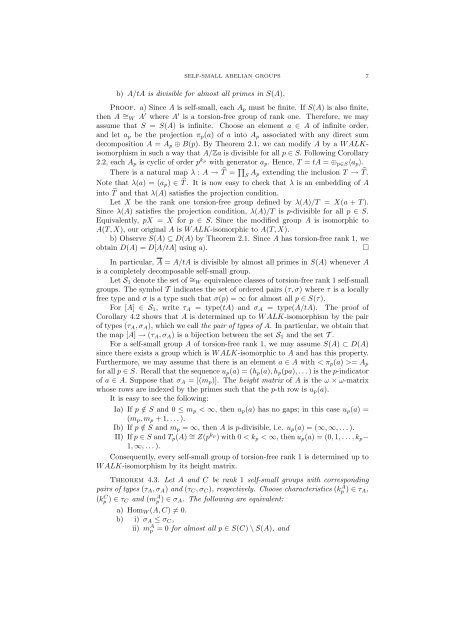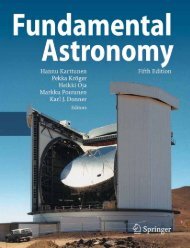Self-small Abelian Groups
Self-small Abelian Groups
Self-small Abelian Groups
Create successful ePaper yourself
Turn your PDF publications into a flip-book with our unique Google optimized e-Paper software.
SELF-SMALL ABELIAN GROUPS 7<br />
b) A/tA is divisible for almost all primes in S(A).<br />
Proof. a) Since A is self-<strong>small</strong>, each Ap must be finite. If S(A) is also finite,<br />
then A ∼ =W A ′ where A ′ is a torsion-free group of rank one. Therefore, we may<br />
assume that S = S(A) is infinite. Choose an element a ∈ A of infinite order,<br />
and let ap be the projection πp(a) of a into Ap associated with any direct sum<br />
decomposition A = Ap ⊕ B(p). By Theorem 2.1, we can modify A by a W ALKisomorphism<br />
in such a way that A/Za is divisible for all p ∈ S. Following Corollary<br />
2.2, each Ap is cyclic of order p kp with generator ap. Hence, T = tA = ⊕p∈S〈ap〉.<br />
There is a natural map λ : A → T = <br />
S Ap extending the inclusion T → T .<br />
Note that λ(a) = (ap) ∈ T . It is now easy to check that λ is an embedding of A<br />
into T and that λ(A) satisfies the projection condition.<br />
Let X be the rank one torsion-free group defined by λ(A)/T = X(a + T ).<br />
Since λ(A) satisfies the projection condition, λ(A)/T is p-divisible for all p ∈ S.<br />
Equivalently, pX = X for p ∈ S. Since the modified group A is isomorphic to<br />
A(T, X), our original A is W ALK-isomorphic to A(T, X).<br />
b) Observe S(A) ⊆ D(A) by Theorem 2.1. Since A has torsion-free rank 1, we<br />
obtain D(A) = D[A/tA] using a). <br />
In particular, A = A/tA is divisible by almost all primes in S(A) whenever A<br />
is a completely decomposable self-<strong>small</strong> group.<br />
Let S1 denote the set of ∼ =W equivalence classes of torsion-free rank 1 self-<strong>small</strong><br />
groups. The symbol T indicates the set of ordered pairs (τ, σ) where τ is a locally<br />
free type and σ is a type such that σ(p) = ∞ for almost all p ∈ S(τ).<br />
For [A] ∈ S1, write τA = type(tA) and σA = type(A/tA). The proof of<br />
Corollary 4.2 shows that A is determined up to W ALK-isomorphism by the pair<br />
of types (τA, σA), which we call the pair of types of A. In particular, we obtain that<br />
the map [A] → (τA, σA) is a bijection between the set S1 and the set T .<br />
For a self-<strong>small</strong> group A of torsion-free rank 1, we may assume S(A) ⊂ D(A)<br />
since there exists a group which is W ALK-isomorphic to A and has this property.<br />
Furthermore, we may assume that there is an element a ∈ A with < πp(a) >= Ap<br />
for all p ∈ S. Recall that the sequence up(a) = (hp(a), hp(pa), . . . ) is the p-indicator<br />
of a ∈ A. Suppose that σA = [(mp)]. The height matrix of A is the ω × ω-matrix<br />
whose rows are indexed by the primes such that the p-th row is up(a).<br />
It is easy to see the following:<br />
Ia) If p /∈ S and 0 ≤ mp < ∞, then up(a) has no gaps; in this case up(a) =<br />
(mp, mp + 1, . . . ).<br />
Ib) If p /∈ S and mp = ∞, then A is p-divisible, i.e. up(a) = (∞, ∞, . . . ).<br />
II) If p ∈ S and Tp(A) ∼ = Z(p kp ) with 0 < kp < ∞, then up(a) = (0, 1, . . . , kp−<br />
1, ∞, . . . ).<br />
Consequently, every self-<strong>small</strong> group of torsion-free rank 1 is determined up to<br />
W ALK-isomorphism by its height matrix.<br />
Theorem 4.3. Let A and C be rank 1 self-<strong>small</strong> groups with corresponding<br />
pairs of types (τA, σA) and (τC, σC), respectively. Choose characteristics (k A p ) ∈ τA,<br />
(k C p ) ∈ τC and (m A p ) ∈ σA. The following are equivalent:<br />
a) HomW (A, C) = 0.<br />
b) i) σA ≤ σC,<br />
ii) m A p = 0 for almost all p ∈ S(C) \ S(A), and
















